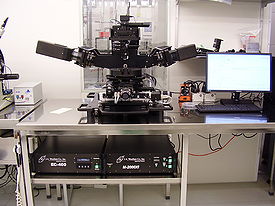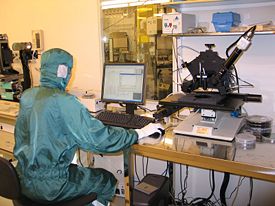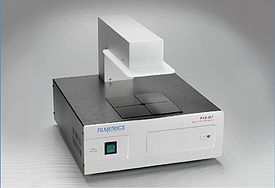Specific Process Knowledge/Characterization/Optical characterization
Feedback to this page: click here
Comparison of the two methods
For comparison of the three methods, see here: Film thickness and optical constants of optical transparent films
Ellipsometer VASE and Ellipsometer M-2000V

The ellipsometer VASE is actually a M2000XI-210 ellipsometer from J.A. Woollam Co., Inc.. We call it VASE (Variable Angle Spectroscopic Ellipsometry) because it can do spectroscopic ellipsometry at variable angles.
The ellipsometer M2000V is an in-situ ellipsometer from J.A. Wollam Co., Inc. This dedicated for being used on the Sputter System Lesker instrument or the ALD2 for in-situ measurements. When it is not on any system it is positioned next to the ALD2.
Ellipsometry is a very sensitive characterization technique which can be used to determine thin film layer thicknesses and/or optical constants. It sends in polarized light on the surface at different angles and measures the change in polarization state of the reflected light.
It is especially good for thin films in the thickness range of a few nanometers to a few microns. The layer should be transparent to light in the usable wavelength range for the thickness to be determined. Large roughness (>40nm) and features within the field of view can cause the measurement to fail.
Ellipsometry is an indirect measurement so a model has to be fit to the data in order to obtain the film thickness and optical constants. To learn more about ellipsometry you can take a look at the tutorial provided by the J. A. Woollam Co.
Access to use the CompleteEASE software can be found using Remote Desktop connection to: 10.51.40.99 (or DCHP-D0037.win.dtu.dk)
The user manuals, quality control procedure and results and contact information can be found in LabManager:
LabManager page for Ellipsometer VASE
LabManager page for Ellipsometer M-2000V
More details
A rough overview of the performance of the Ellipsometers
| Equipment | Ellipsometer VASE | Ellipsometer M-2000V | |
|---|---|---|---|
| Purpose |
|
| |
| Performance | Films that can be examined |
Any film that is transparent to the light in the given wavelength range e.g.:
|
Any film that is transparent to the light in the given wavelength range e.g.:
|
| Film thickness range |
|
| |
| Process parameter range | Wavelength range |
|
|
| Incident angle range |
|
| |
| Beam size |
|
| |
| Mapping facility |
|
| |
| Accessories | Focusing optics |
|
|
| Transmission stage |
|
| |
| Substrates | Batch size |
|
|
| Allowed materials |
|
| |
Filmtek 4000

FilmTek 4000 is a computerized film thickness measurement and material characterization system. This system combines fiber-optic spectrophotometry with advanced material modeling software to provide an affordable and reliable tool for the simultaneous measurement of film thickness, index of refraction, and extinction coefficient
Normal incidence and polarized 70 degree reflection data is collected and used to calculate thickness and index of refraction of the measured film using SCI’s patented Differential Power Spectral Density (DPSD) technique. Absolute reflection data is obtained by comparing sample data to the measured reflection of a known reference sample, typically a silicon wafer with a thermally grown thin oxide (~63 nm) film.
The spectrophotometer scans the sample over a predefined range of wavelengths. The software generates a reflection spectrum based on a previously stored reference scan, and then performs a regression on the unknown parameters to fit the simulated reflection and power spectral density to the observed values. The resulting thin film parameters along with the measured and modeled spectra are then displayed for the user to examine.
The user manual, quality control procedure and results, technical information and contact information can be found in LabManager:
An overview of the performance of the FilmTek
| Purpose | Film thickness measurements and optical characterization of optically transparent thin films |
|
|---|---|---|
| Performance | Thin film materials that can be measured |
Any film that is transparent to the light in the given wavelength range ex:
|
| Film thickness range |
| |
| Process parameter range | Wavelength range |
|
| Substrates | Batch size |
|
| Substrate material allowed |
|
F10-RT reflectometer, transmitance, film thickness measurements 

F10-RT is a combined reflectance and transmittance measurement system that can also use the reflectance measurements to get the film thickness of transparent thin films. This system combines fiber-optic spectrophotometry with material modeling software to provide an affordable tool for the measurement of reflectance, transmitance and film thickness.
Reflectance and transmittance spectra can be obtained simultaneously. Normal incidence reflection data is collected and used to calculate thickness and index of refraction of the measured film. Absolute reflection data is obtained by comparing sample data to the measured reflection of a known reference sample.
The spectrophotometer scans the sample over a predefined range of wavelengths. The software generates a reflection spectrum based on a previous measured reference scan, and then performs a regression on the unknown parameters to fit the simulated reflection. The resulting thin film parameters along with the measured and modeled spectra are then displayed for the user to examine.
The user manual, quality control procedure and results, technical information and contact information can be found in LabManager:
An overview of the performance of the F10-RT
| Purpose | Reflectance, transmittance and film thickness measurements optically transparent thin films | |
|---|---|---|
| Performance | Thin film materials that can be measured |
Reflectance: any flat suface larger than 6mm
|
| Film thickness range |
| |
| Probe spot size |
| |
| Sample orientation |
| |
| Process parameter range | Wavelength range |
|
| Substrates | Batch size |
|
| Substrate material allowed |
|
